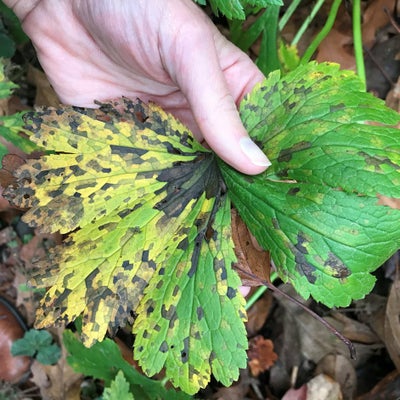
Quick facts
Common names - Foliar nematode, leaf and bud nematode, chrysanthemum eelworm
Scientific names - Aphelenchoides ritzemabosi and A. fragariae
Plants affected - Very wide host range including chrysanthemums, ferns, lilies, violets, begonias, strawberries etc.
Main symptoms - Characteristic interveinal yellow, brown and black blotches most apparent at the end of growth season
Caused by - Plant parasitic nematode
Timing - In sheltered locations can be present all year round
What is leaf and bud eelworm?
Nematodes are multicellular, unsegmented, worm-like animals. Foliar nematodes are plant-parasitic.
The Nematoda is a very diverse phylum of animals with more than 25 000 described species. Their adaptability to almost every habitat including soil, freshwater, marine and all climatic zones is what makes them so successful. Nematodes are essential to ecosystems including the garden; a large proportion are free-living nematodes helping break down and recycle organic material. Other species are obligate parasites (i.e. cannot complete their life cycles without a host) of plants and animals.
Foliar nematodes feed within plants. They are microscopic (0.4-1.2 mm) and slender with a stylet or mouth spear. The stylet is used to puncture plant cells, inject digestive juices and ingest plant fluids. They are migratory endoparasites which means they can move into, through, and out of their host tissue. Their movement and feeding causes cell damage or death and the affected plant will usually show discolouration and distortion. Juveniles and adults need a film of water to migrate within the soil but also on the stems and leaves of their hosts.
They have lifecycle of 11 to 14 days at 13⁰C to 23⁰C but can multiply in plant tissue when temperatures are as low as -2⁰C. Adults overwinter in , seeds and dry plant parts until favourable conditions arise in spring. Populations thrive in warm, humid conditions. They cannot survive in the soil for more than three months without a host.
Symptoms
The symptoms described below can also be typical of some nutrient deficiencies and disease. Confirming foliar nematodes are present usually requires laboratory examination of plant material.
Aphelchoidesritzemabosi on chrysanthemums
Stunted growth, and plants with a bushy appearance due to damage of growth points and . Distorted and deformed leaves with interveinal yellowed blotches turning brown, later black, typically at the end of the growth season. With time leaves shrivel, die and hang down. Infected flower buds produce deformed undersized flowers.
Aphelenchoides fragariae on strawberries, ferns and peonies
Initial symptoms are stunted and deformed buds, leaves and flowers. Twisting and puckering of leaves or undersized leaves with crinkled edges, and tight aggregation of crowns, reddened and stunted growth and flower stalks with aborted or partly aborted flowers. Heavily affected plants do not produce fruit. On ferns, leaf blotches occur in stripes as their movement seems to be delimited by veins. On plants such as peonies and basil symptoms appear as water-soaked patches which later turn purple then brown.

Management
Cultural methods can be used to reduce infection and minimise damage.
Purchase nematode-free plant material. Avoid introducing foliar nematodes into your garden by thoroughly inspecting plant material for symptoms and buying from reputable suppliers.
Sanitation is critical for control. To manage and restrict spread remove and dispose of all infected plant material and control weeds which could be potential hosts. Thoroughly clean contaminated gardening equipment and muddy shoes. See disposal of diseased material for more details.
Avoid overhead irrigation. The mobility of nematodes on the surface of plants depends on the presence of a water film so avoid overhead irrigation such as sprinklers to reduce the risk of dispersing nematodes between plants.
resistance. Host plants vary in susceptibility but the knowledge of which varieties are resistant is lacking. Research conducted in the first half of the 20th century indicated that chrysanthemum varieties varied in susceptibility to foliar nematode. Some varieties that may be commercially hard to find (e.g. ‛Amy Shoesmith’, ‛Orange Beauty’ and ‛Orange Peach Blossom’) were shown to be resistant but not immune. Foliar nematodes can invade these cultivars but females produce few eggs and juveniles so usually fail to mature. In time the nematode population will fall to insignificant numbers. There is a need for more research in this area as there have been significant advances in breeding.






